Apply to Aakash iACST Scholarship Test 2024
NCERT Solutions for Class 12 Physics Chapter 4 Moving Charges and Magnetism
NCERT Solutions for Class 12 Physics Chapter 4 – Access and Download PDF for Free
NCERT Solutions for Class 12 Physics Chapter 4 Moving Charges and Magnetism: If you're a Class 12 student in search of NCERT solutions, you've come to the right place. On this page, you'll find comprehensive class 12 physics chapter 4 ncert solutions from questions 1 to 28. Our class 12 physics ch 4 ncert solutions have been meticulously crafted by subject experts, providing detailed explanations for each step. Also, you have the option to download these solutions in PDF format, enabling you to work on them offline as well.
- NCERT Solutions for Class 12 Physics Chapter 4 – Access and Download PDF for Free
- NCERT Solutions for Class 12 Physics Chapter 4 Moving Charges and Magnetism
- Class 12 Physics ch 4 Exercise solutions
- Moving Charges And Magnetism Class 12 Main Topics-
- NCERT Solutions Subject Wise
- Importance of NCERT solutions for class 12 physics chapter 4 moving charges and magnetism in exams:
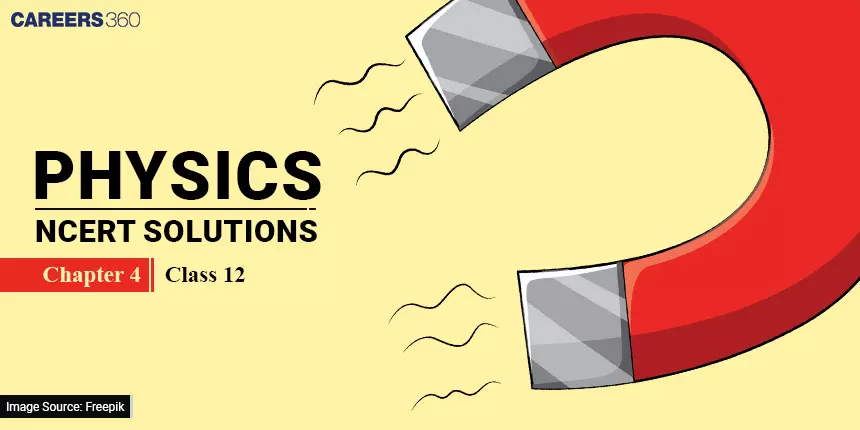
A moving charge in a magnetic field can produce a force and a current-carrying conductor in a uniform magnetic field will experience a force. The solutions of NCERT Class 12 Physics Chapter 4 Moving Charges and Magnetism cover problems based on these two basic concepts. Class 12 chapter 4 physics ncert solutions will help you to boost the concepts studied in this chapter of the NCERT syllabus.
Two main laws discussed in the NCERT chapter Moving charges and Magnetism Class 12 are Ampere's law and Biot-savant law. Based on these laws many problems are discussed in CBSE NCERT solutions for Class 12 Physics Chapter 4 Moving Charges and Magnetism. The galvanometer is discussed in Moving charges and Magnetism Class 12 in detail with its working principle. NCERT Solutions for Class 12 Physics Chapter 4 Moving charges and Magnetism helps students for solving homework problems.
The right-hand thumb rule, Flemings right-hand rule and Flemings left-hand rule are three important concepts of Moving charges and Magnetism chapter of NCERT textbook. The problems related to finding the directions can be solved using these three rules or by using the concepts of vectors. The NCERT solutions for Class 12 Physics also helps in preparing for competitive exams like NEET and JEE Mains.
Free download class 12 chapter 4 physics ncert solutions PDF for CBSE exam.
NCERT Solutions for Class 12 Physics Chapter 4 Moving Charges and Magnetism
Answer :
The magnitude of the magnetic field at the centre of a circular coil of radius r carrying current I is given by,
For 100 turns, the magnitude of the magnetic field will be,
(current=0.4A, radius = 0.08m, permeability of free space = 4
10 -7 TmA -1 )
Answer:
The magnitude of the magnetic field at a distance r from a long straight wire carrying current I is given by,
In this case
(current=35A, distance= 0.2m, permeability of free space = 4
10 -7 TmA -1 )
Answer:
The magnitude of the magnetic field at a distance r from a long straight wire carrying current I is given by,
In this case
(current=50A, distance= 2.5m, permeability of free space = 4
10 -7 TmA -1 )
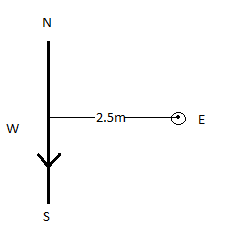 The current is going from the North to South direction in the horizontal plane and the point lies to the East of the wire. Applying Maxwell's right-hand thumb rule we can see that the direction of the magnetic field will be vertically upwards.
The current is going from the North to South direction in the horizontal plane and the point lies to the East of the wire. Applying Maxwell's right-hand thumb rule we can see that the direction of the magnetic field will be vertically upwards.
Answer:
The magnitude of the magnetic field at a distance r from a long straight wire carrying current I is given by,
In this case (current=35A, distance= 0.2m, permeability of free space = 4 10 -7 TmA -1 )
The current in the overhead power line is going from the East to West direction and the point lies below the power line. Applying Maxwell's right-hand thumb rule we can see that the direction of the magnetic field will be towards the South.
Answer:
The magnetic force on an infinitesimal current-carrying conductor in a magnetic field is given by where the direction of vector dl is in the direction of flow of current.
For a straight wire of length l in a uniform magnetic field, the Force equals to
In the given case the magnitude of force per unit length is equal to
|F| = 0.15 8
sin30 o (I=8A, B=0.15 T,
=30 o )
=0.6 Nm -1
Answer:
For a straight wire of length l in a uniform magnetic field, the Force equals to
In the given case the magnitude of the force is equal to
|F| = 0.27 10
0.03
sin90 o (I=10A, B=0.27 T,
=90 o )
=0.081 N
The direction of this force depends on the orientation of the coil and the current-carrying wire and can be known using the Flemings Left-hand rule.
Answer:
The magnitude of magnetic field at a distance r from a long straight wire carrying current I is given by,
In this case the magnetic field at a distance of 4.0 cm from wire B will be
(I=5 A, r=4.0 cm)
The force on a straight wire of length l carrying current I in a uniform magnetic field B is given by
, where
is the angle between the direction of flow of current and the magnetic field.
The force on a 10 cm section of wire A will be
(B=2.5 T, I=8 A, l = 10 cm,
=90 o )
Answer:
The magnitude of the magnetic field at the centre of a solenoid of length l, total turns N and carrying current I is given by
, where
is the permeability of free space.
In the given question N= number of layers of winding number of turns per each winding
N=5 400=2000
I=8.0 A
l=80 cm
Answer:
The magnitude of torque experienced by a current-carrying coil in a magnetic field is given by
where n = number of turns, I is the current in the coil, A is the area of the coil and is the angle between the magnetic field and the vector normal to the plane of the coil.
In the given question n = 20, B=0.8 T, A=0.1 0.1=0.01 m 2 , I=12 A,
=30 o
=0.96 Nm
The coil, therefore, experiences a torque of magnitude 0.96 Nm.
10 (a) Two moving coil meters, and
have the following particulars:
Answer:
The torque experienced by the moving coil M 1 for a current I passing through it will be equal to
The coil will experience a restoring torque proportional to the twist
The current sensitivity is therefore
Similarly, for the coil M 2, current sensitivity is
Their ratio of current sensitivity of coil M 2 to that of coil M 1 is, therefore,
10.(b) Two moving coil meters, and
have the following particulars:
(The spring constants are identical for the two meters).
Determine the ratio of voltage sensitivity of and
Answer:
The torque experienced by the moving coil M 1 for a current I passing through it will be equal to
The coil will experience a restoring torque proportional to the twist
we know V=IR
Therefore,
Voltage sensitivity of coil M 1 =
Similarly for coil M 2 Voltage sensitivity =
Their ratio of voltage sensitivity of coil M 2 to that of coil M 1
Answer:
The magnetic force on a moving charged particle in a magnetic field is given by
Since the velocity of the shot electron is perpendicular to the magnetic field, there is no component of velocity along the magnetic field and therefore the only force on the electron will be due to the magnetic field and will be acting as a centripetal force causing the electron to move in a circular path. (if the initial velocity of the electron had a component along the direction of the magnetic field it would have moved in a helical path)
Magnetic field(B)=
Speed of electron(v)=
Charge of electron=
Mass of electron=
The angle between the direction of velocity and the magnetic field = 90 o
Since the force due to the magnetic field is the only force acting on the particle,
Answer:
In exercise 4.11 we saw
Time taken in covering the circular path once(time period (T))=
Frequency,
From the above equation, we can see that this frequency is independent of the speed of the electron.
13 (a) A circular coil of 30 turns and radius 8.0 cm carrying a current of 6.0 A is suspended vertically in a uniform horizontal magnetic field of magnitude 1.0 T. The field lines make an angle of with the normal of the coil. Calculate the magnitude of the counter torque that must be applied to prevent the coil from turning.
Answer:
Number of turns in the coil(n)=30
The radius of the circular coil(r)=8.0 cm
Current flowing through the coil=6.0 A
Strength of magnetic field=1.0 T
The angle between the field lines and the normal of the coil=60 o
The magnitude of the counter-torque that must be applied to prevent the coil from turning would be equal to the magnitude of the torque acting on the coil due to the magnetic field.
=3.13 Nm
A torque of magnitude 3.13 Nm must be applied to prevent the coil from turning.
Answer:
From the relation we can see that the torque acting on the coil depends only on the area and not its shape, therefore, the answer won't change if the circular coil in (a) were replaced by a planar coil of some irregular shape that encloses the same area.
NCERT solutions for moving charges and magnetism additional exercise:
Answer:
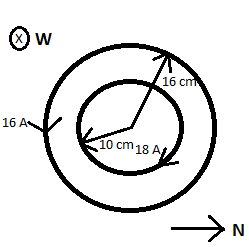
Using the right-hand thumb rule we can see that the direction of the magnetic field due to coil X will be towards the east direction and that due to coil Y will be in the West direction.
We know the magnetic field at the centre of a circular loop of radius r carrying current I is given by
(towards East)
(towards west)
The net magnetic field at the centre of the coils,
B net =B y - B x
=1.57 10 -3 T
The direction of the magnetic field at the centre of the coils is towards the west direction.
Answer:
Strength of the magnetic field required is
nI
Therefore keeping the number of turns per unit length and the value of current within the prescribed limits such that their product is approximately 8000 we can produce the required magnetic field.
e.g. n=800 and I=10 A.
Show that this reduces to the familiar result for the field at the centre of the coil.
Answer:
For a circular coil of radius R and N turns carrying current I, the magnitude of the magnetic field at a point on its axis at a distance x from its centre is given by,
For finding the field at the centre of coil we put x=0 and get the familiar result
Answer:
Let a point P be at a distance of l from the midpoint of the centres of the coils.
The distance of this point from the centre of one coil would be R/2+l and that from the other would be R/2-l.
The magnetic field at P due to one of the coils would be
.
The magnetic field at P due to the other coil would be
Since the direction of current in both the coils is same the magnetic fields B 1 and B 2 due to them at point P would be in the same direction
B net =B 1 +B 2
Since l<<R we can ignore term l 2 /R 2
Since the above value is independent of l for small values it is proved that about the midpoint the Magnetic field is uniform.
Answer:
Outside the toroid, the magnetic field will be zero.
Answer:
The magnetic field inside the core of a toroid is given by
Total number of turns(N)=3500
Current flowing in toroid =11 A
Length of the toroid, l=
(r 1 =inner radius=25 cm, r 2 =outer radius=26 cm)
Answer:
The magnetic field in the empty space surrounded by the toroid is zero.
Answer:
The charged particle is not deflected by the magnetic field even while having a non zero velocity, therefore, its initial velocity must be either parallel or anti-parallel to the magnetic field i.e. It's velocity is either towards the east or the west direction.
Answer:
Yes, its final speed will be equal to the initial speed if it has not undergone any collision as the work done by the magnetic field on a charged particle is always zero because it acts perpendicular to the velocity of the particle.
Answer:
The electron would experience an electrostatic force towards the north direction, therefore, to nullify its force due to the magnetic field must be acting on the electron towards the south direction. By using Fleming's left-hand rule we can see that the force will be in the north direction if the magnetic field is in the vertically downward direction.
Explanation:
The electron is moving towards the east and has a negative charge therefore is towards the west direction, Force will be towards south direction if the magnetic field is in the vertically downward direction as
Answer:
(a) The electron has been accelerated through a potential difference of 2.0 kV.
Therefore K.E of electron =
Since the electron initially has velocity perpendicular to the magnetic field it will move in a circular path.
The magnetic field acts as a centripetal force. Therefore,
Answer:
The electron has been accelerated through a potential difference of 2.0 kV.
Therefore K.E of electron = 1.6 10 -19
2000=3.2
10 -16 J
The component of velocity perpendicular to the magnetic field is
The electron will move in a helical path of radius r given by the relation,
r=5m
r=5 10 -4 m
r=0.5 mm
The component of velocity along the magnetic field is
The electron will move in a helical path of pitch p given by the relation,
p=5.45 10 -3 m
p=5.45 mm
The electron will, therefore, move in a helical path of radius 5 mm and pitch 5.45 mm.
Answer:
(i)
Let the beam consist of particles having charge q and mass m.
After being accelerated through a potential difference V its velocity can be found out by using the following relation,
(ii)
Using the value of v from equation (ii) in (i) we have
Answer:
In order for the tension in the wires to be zero the force due to the magnetic field must be equal to the gravitational force on the rod.
mass of rod=0.06 g
length of rod=0.45m
the current flowing through the rod=5 A
A magnetic field of strength 0.261 T should be set up normal to the conductor in order that the tension in the wires is zero
Answer:
If the direction of the current is reversed the magnetic force would act in the same direction as that of gravity.
Total tension in wires(T)=Gravitational force on rod + Magnetic force on rod
The total tension in the wires will be 1.176 N.
Answer:
Since the distance between the wires is much smaller than the length of the wires we can calculate the Force per unit length on the wires using the following relation.
Current in both wires=300 A
Distance between the wires=1.5 cm
Permeability of free space=4 10 -7 TmA -1
F=1.2 Nm -1
Answer:
The length of wire inside the magnetic field is equal to the diameter of the cylindrical region=20.0 cm=0.2 m.
Magnetic field strenth=1.5 T.
Current flowing through the wire=7.0 A
The angle between the direction of the current and magnetic field=90 o
Force on a wire in a magnetic field is calculated by relation,
F=2.1 N
This force due to the magnetic field inside the cylindrical region acts on the wire in the vertically downward direction.
Answer:
Magnetic field strenth=1.5 T.
Current flowing through the wire=7.0 A
The angle between the direction of the current and magnetic field=45 o
The radius of the cylindrical region=10.0 cm
The length of wire inside the magnetic field,
Force on a wire in a magnetic field is calculated by relation,
F=2.1 N
This force due to the magnetic field inside the cylindrical region acts on the wire in the vertically downward direction.
This force will be independent of the angle between the wire and the magnetic field as we can see in the above case.
Note: There is one case in which the force will be zero and that will happen when the wire is kept along the axis of the cylindrical region.
Answer:
The wire is lowered by a distance d=6cm.
In this case, the length of the wire inside the cylindrical region decreases.
Let this length be l.
F=1.68 N
This force acts in the vertically downward direction.

Answer:
The magnetic field is
Current in the loop=12 A
Area of the loop = length breadth
A=0.1 0.05
A=0.005 m 2
The torque on the loop has a magnitude of 0.018 Nm and acts along the negative-y direction. The force on the loop is zero.

Answer:
The magnetic field is
Current in the loop=12 A
Area of the loop = length breadth
A=0.1 0.05
A=0.005 m 2
(same as that in the last case)
The torque on the loop has a magnitude of 0.018 Nm and acts along the negative-y direction. The force on the loop is zero. This was exactly the case in 24. (a) as well.
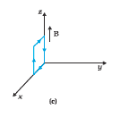
Answer:
The magnetic field is
Current in the loop=12 A
Area of the loop = length breadth
A=0.1 0.05
A=0.005 m 2
The torque on the loop has a magnitude of 0.018 Nm and acts along the negative-x-direction. The force on the loop is zero.
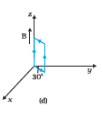
Answer:
The magnetic field is
Current in the loop=12 A
Area of the loop = length breadth
A=0.1 0.05
A=0.005 m 2
The torque on the loop has a magnitude of 0.018 Nm and at an angle of 240 o from the positive x-direction. The force on the loop is zero.
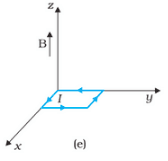
Answer:
The magnetic field is
Current in the loop=12 A
Area of the loop = length breadth
A=0.1 0.05
A=0.005 m 2
Since the area vector is along the direction of the magnetic field the torque on the loop is zero. The force on the loop is zero.
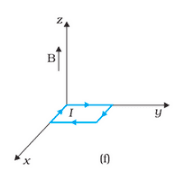
Answer:
The magnetic field is
Current in the loop=12 A
Area of the loop = length breadth
A=0.1 0.05
A=0.005 m 2
Since the area vector is in the opposite direction of the magnetic field the torque on the loop is zero. The force on the loop is zero.
The force on the loop in all the above cases is zero as the magnetic field is uniform
Answer:
As we know the torque on a current-carrying loop in a magnetic field is given by the following relation
It is clear that the torque, in this case, will be 0 as the area vector is along the magnetic field only.
Answer:
The total force on the coil will be zero as the magnetic field is uniform.
Answer:
The average force on each electron in the coil due to the magnetic field will be eV d B where V d is the drift velocity of the electrons.
The current is given by
where n is the free electron density and A is the cross-sectional area.
The average force on each electron is
Answer:
The magnetic field inside the solenoid is given by
n is number of turns per unit length
n=1500 m -1
Current in the wire I w = 6 A
Mass of the wire m = 2.5 g
Length of the wire l = 2 cm
The windings of the solenoid would support the weight of the wire when the force due to the magnetic field inside the solenoid balances weight of the wire
Therefore a current of 108.37 A in the solenoid would support the wire.
Answer:
The galvanometer can be converted into a voltmeter by connecting an appropriate resistor of resistance R in series with it.
At the full-scale deflection current(I) of 3 mA the voltmeter must measure a Voltage of 18 V.
The resistance of the galvanometer coil G =
The galvanometer can be converted into a voltmeter by connecting a resistor of resistance in series with it.
Answer:
The galvanometer can be converted into an ammeter by connecting an appropriate resistor of resistance R in series with it.
At the full-scale deflection current(I) of 4 mA, the ammeter must measure a current of 6 A.
The resistance of the galvanometer coil is G =
Since the resistor and galvanometer coil are connected in parallel the potential difference is the same across them.
The galvanometer can be converted into an ammeter by connecting a resistor of resistance in parallel with it.
Understanding moving charges and magnetism class 12 ncert solutions is like building the foundation of a tall building. It helps you do well in your regular school exams (like the bricks at the bottom) and is also crucial for clearing tough entrance exams like JEE and NEET (like the support structure that holds up the building). So, it's important for both your regular studies and future career goals.
Class 12 physics chapter 4 exercise solutions: Important Formulas and Diagrams
Important formulas of physics chapter 4 class 12 ncert solutions are listed below:
Force Applied To A Moving Charge
SAT® | CollegeBoard
Registeration closing on 19th Apr for SAT® | One Test-Many Universities | 90% discount on registrations fee | Free Practice | Multiple Attempts | no penalty for guessing
TOEFL ® Registrations 2024
Thinking of Studying Abroad? Think the TOEFL® test. Save 10% on your TOEFL exam with ApplyShop gift cards!
![]()
Biot-Savart’s Law
![]()
![]()
Ampere Circuital Law
![]()
Cyclotron
Centripetal force=magnetic Lorentz force![]()
Cyclotron frequency =![]()
Cyclotron angular frequency = ![]()
Maximum kinetic energy of the particle =![]()
Moving Charges And Magnetism Class 12 Main Topics-
The following topics are covered in ch 4 Physics Class 12:
Magnetic Force- The force on a moving charge in a uniform magnetic field and also a force on a current-carrying conductor in a magnetic field are discussed in chapter 4 Physics Class 12. Some questions based on these concepts are discussed in the Class 12 Physics Chapter 4 NCERT solutions. For example questions, 5, 11, 18 and 23 of NCERT solutions for Class 12 Physics Chapter 4 uses the concepts of force on a charge/conductor in a uniform magnetic field.
Motion in a magnetic field- This part of Moving charges and Magnetism Class 12 discusses the trajectory of a charge in a magnetic field. Questions based on this are discussed in the Moving Charges and Magnetism solutions given above.
The motion of combined electric and magnetic field- The motion of charge in the presence of both electric and magnetic fields and also the topic cyclotron is discussed in this portion of Class 12 NCERT Physics.
Biot-Savart law, Amperes circuital law- These two laws and their applications are discussed in Physics chapter 4 Class 12.
Other topics discussed in class 12 physics chapter 4 question answer are solenoid, toroid, the force between parallel conductors, torques on a rectangular loop in a magnetic field, the angular momentum of the electron and the concept of moving coil galvanometer and conversion of galvanometer to ammeter and voltmeter. Understanding the formulas and concepts in these topics are important to get a better idea while solving the problems.
Key Features of moving charges and magnetism class 12 ncert solutions
Comprehensive Coverage: The class 12 physics chapter 4 exercise solutions cover all the topics and questions presented in the Class 12 Physics Chapter "Moving Charges and Magnetism."
Step-by-Step Explanations: Each class 12 physics chapter 4 question answer provides detailed step-by-step explanations, helping students understand complex concepts.
Clarity and Simplicity: The physics chapter 4 class 12 ncert solutions are written in clear and simple language, making it easier for students to comprehend the content.
Practice Questions: Exercise questions are included to help students practice and assess their understanding.
Exam Preparation: These class 12 physics ch 4 exercise solutions aid students in preparing effectively for board exams and competitive exams like JEE and NEET.
Foundation for Advanced Topics: The concepts covered in this chapter are essential for more advanced topics in physics and electrical engineering.
Free Access: These solutions are available for free, ensuring accessibility to all students.
These features make the Class 12 "Moving Charges and Magnetism" solution a valuable resource for students, facilitating their success in exams and future studies.
Also Check NCERT Books and NCERT Syllabus here:
- NCERT Books Class 12 Physics
- NCERT Syllabus Class 12 Physics
- NCERT Books Class 12
- NCERT Syllabus Class 12
NCERT Exemplar Class 12 Solutions
NCERT Solutions For Class 12 Physics Chapter - Wise
NCERT Solutions Subject Wise
- NCERT solutions for Class 12 Mathematics
- NCERT solutions for Class 12 Chemistry
- NCERT solutions for Class 12 Physics
- NCERT solutions for Class 12 Biology
Importance of NCERT solutions for class 12 physics chapter 4 moving charges and magnetism in exams:
As CBSE board exam is concerned, the solutions of NCERT Class 12 Physics chapter 4 Moving Charges and Magnetism is important. In 2019 CBSE board exam 12 % of questions are asked from chapter 4 and 5. Same questions discussed in the chapter 4 Physics Class 12 NCERT solutions can be expected in the board exams. NCERT Exemplar Class 12 Physics Solutions
Frequently Asked Question (FAQs)
The chapter Moving Charges and Magnetism have 8 to 10 percentage weightage. The questions asked from the chapter can be of a numerical, derivation or theory questions. CBSE board follows NCERT Syllabus. To practice problems refer to NCERT text book, NCERT syllabus and previous year board papers of Class 12 Physics.
No, you can not skip it. Since from NCERT Class 12 Physics chapter 4 you can expect 2 questions for NEET exam.
No, you have to practise more questions for doing well in JEE main exams. The questions of Moving Charges and Magnetism need a good base of vectors and a thorough understanding of concepts
Electromagnetic theory is a theory that explains the relationship between electric fields and magnetic fields. It is based on the idea that electric and magnetic fields are two different aspects of the same underlying electromagnetic field.
Magnetic resonance imaging (MRI) is a medical technique that uses a strong magnetic field and radio waves to create detailed images of the inside of the body. It is used to diagnose a wide range of medical conditions.
Also Read
Articles
Certifications By Top Providers
Explore Top Universities Across Globe
Questions related to CBSE Class 12th
Hello aspirant,
The purpose of graphic design extends beyond the brand's look. Nevertheless, by conveying what the brand stands for, it significantly aids in the development of a sense of understanding between a company and its audience. The future in the field of graphic designing is very promising.
There are various courses available for graphic designing. To know more information about these courses and much more details, you can visit our website by clicking on the link given below.
https://www.careers360.com/courses/graphic-designing-course
Thank you
Hope this information helps you.
hello,
Yes you can appear for the compartment paper again since CBSE gives three chances to a candidate to clear his/her exams so you still have two more attempts. However, you can appear for your improvement paper for all subjects but you cannot appear for the ones in which you have failed.
I hope this was helpful!
Good Luck
Hello dear,
If you was not able to clear 1st compartment and now you giving second compartment so YES, you can go for your improvement exam next year but if a student receives an improvement, they are given the opportunity to retake the boards as a private candidate the following year, but there are some requirements. First, the student must pass all of their subjects; if they received a compartment in any subject, they must then pass the compartment exam before being eligible for the improvement.
As you can registered yourself as private candidate for giving your improvement exam of 12 standard CBSE(Central Board of Secondary Education).For that you have to wait for a whole year which is bit difficult for you.
Positive side of waiting for whole year is you have a whole year to preparing yourself for your examination. You have no distraction or something which may causes your failure in the exams. In whole year you have to stay focused on your 12 standard examination for doing well in it. By this you get a highest marks as a comparison of others.
Believe in Yourself! You can make anything happen
All the very best.
Hello Student,
I appreciate your Interest in education. See the improvement is not restricted to one subject or multiple subjects and we cannot say if improvement in one subject in one year leads to improvement in more subjects in coming year.
You just need to have a revision of all subjects what you have completed in the school. have a revision and practice of subjects and concepts helps you better.
All the best.
Hi,
You just need to give the exams for the concerned two subjects in which you have got RT. There is no need to give exam for all of your subjects, you can just fill the form for the two subjects only.
Popular CBSE Class 12th Questions
Colleges After 12th
Also Read
Applications for Admissions are open.

JEE Main Important Physics formulas
ApplyAs per latest 2024 syllabus. Physics formulas, equations, & laws of class 11 & 12th chapters

UPES School of Liberal Studies
ApplyRanked #52 Among Universities in India by NIRF | Up to 30% Merit-based Scholarships | Lifetime placement assistance

Aakash iACST Scholarship Test 2024
ApplyGet up to 90% scholarship on NEET, JEE & Foundation courses

JEE Main Important Chemistry formulas
ApplyAs per latest 2024 syllabus. Chemistry formulas, equations, & laws of class 11 & 12th chapters

PACE IIT & Medical, Financial District, Hyd
ApplyEnrol in PACE IIT & Medical, Financial District, Hyd for JEE/NEET preparation

ALLEN JEE Exam Prep
ApplyStart your JEE preparation with ALLEN
